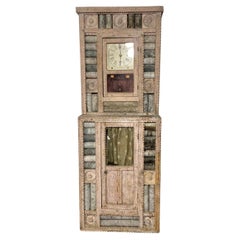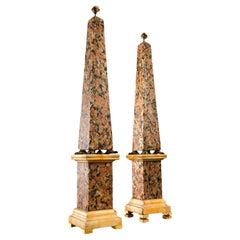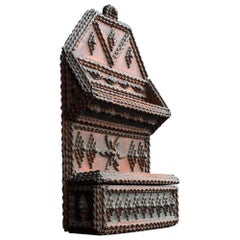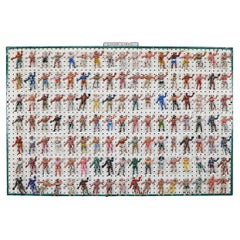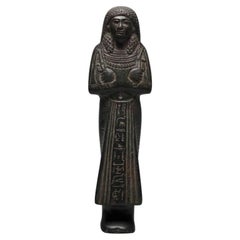Granite Antiquities
to
1
1
1
2
1
2
1,280
557
531
244
148
1
1
1
1
2
2
2
Material: Granite
Unusual Tramp Art / Folk Art Wood and Stone Clock, sculpture. cabinet.
Located in Buffalo, NY
Unusual Tramp Art / Folk Art Wood and Stone (granite) Clock, sculpture. cabinet.. Amazing decorative item.Antique hand crafted,Stone ,granite cylinders,
Category
1890s American Folk Art Antique Granite Antiquities
Materials
Stone, Granite
Pair of Obelisks Italy Third Quarter 19th Century
By Non-Standard Furniture and Lighting
Located in Milano, IT
Pair of Red Granite obelisks surmounted by two gilded bronze terrestrial and celestial globes. The obelisks rest on two plinths also made of granite with base and capital of Giallo d...
Category
1880s Italian Other Antique Granite Antiquities
Materials
Granite, Bronze
$4,697 Sale Price / set
20% Off
Related Items
Exceptional 19th Century American Tramp Art Candle Box
Located in London, GB
Exceptional 19th century American Tramp Art candle box
We are proud to offer an exceptionally rare example of a mid-19th century handcrafted American Tramp Art Folk Art wall-mounted...
Category
1870s American Folk Art Antique Granite Antiquities
Materials
Wood
Decorative Wall Panel Made with Mexican Wrestlers (Folk Art)
Located in Mexico City, CDMX
Circa 1970. We offer this Rare Decorative Wall Panel Made with Mexican Wrestlers Toys (Folk Art).
Category
1970s Mexican Folk Art Vintage Granite Antiquities
Materials
Plastic
19th Century Mortar and Pestle
Located in Coeur d'Alene, ID
19th century fruitwood mortar and pestle. Remnants of oxblood red and silver blue banded paint. Original pestle included.
Origin: Eastern, United States
Period: First half of the 19...
Category
Early 19th Century American Antique Granite Antiquities
Materials
Fruitwood
19th Century English Sword Cane
Located in Coeur d'Alene, ID
English sword cane with a fine toledo blade that measures approximately 27 1/2". Triangular blade marked "Toledo" on the ricasso and is beautifully decorated with etched and fire blued panels which also exhibit areas of gold wash. The decorations travel for about half the length of the blade. The cane measures approximately 35 1/2" and features a nice scalloped and flowered decoration with brass ferrule. Good condition. Blade remains bright and locks into scabbard properly. Nice patina to handle.
PERIOD: Late 19th Century
ORIGIN: English
SIZE: 35 1/2" x 5"
Check out our large selection of 19th and 20th Century canes including sword canes and gun canes...
Category
19th Century English Antique Granite Antiquities
Materials
Brass
Ancient Pair of Carved Wooden Sculptures of Horses, 19th Century
Located in Cuneo, Italy (CN)
Ancient pair of carved hardwood sculptures, depicting a pair of trotting horses, sculpted in the 19th century.
They measure about W 7 x H 30 x T 30 cm.
Category
Early 19th Century European Antique Granite Antiquities
Materials
Wood
$1,141 Sale Price
20% Off
H 11.82 in W 11.82 in D 2.76 in
Mid Century Folk Art Viking Ship in Wood 1960s
Located in Meer, VAN
Mid Century Folk Art Viking Ship in Wood 1960s.
Beautiful folk art viking ship, made by a craftsman at home or maybe as a school project somewhere around the 1960s or 1970s. Wonderf...
Category
Mid-20th Century European Mid-Century Modern Granite Antiquities
Materials
Wood, Pine
Antique Spanish Colonial Folk Art Santos Figure folk art sculpture
Located in London, GB
Antique Spanish Colonial Poly chrome Folk Art Santos figure probably Philippines The finely sculptured large hard wood figure standing on a pedestal base, painted in polychrome col...
Category
18th Century Peruvian Antique Granite Antiquities
Materials
Gesso, Wood
$616
H 18.12 in W 3.94 in D 3.94 in
Folk Art Walking Stick, Germany, 1890
Located in Milan, IT
Folk art walking stick: carved wooden handle depicting a Great Dane dog’s head, sulphur glass eyes. Fruit wood shaft and metal ferrule. Germany ...
Category
Late 19th Century German Antique Granite Antiquities
Materials
Metal
19th Century Coffee Grinder
Located in Louisville, KY
This well-preserved piece of American Coffee history is a site to behold. With it's ornately decorated iron grinder sitting atop an oak base joined with beautiful small dovetail jo...
Category
Late 19th Century American Adirondack Antique Granite Antiquities
Materials
Wrought Iron
A fine Kuba Mask - Rustic African Folk Art
Located in Skien, NO
Ngaady aMwaash Mask. African Antique Folk Art Kuba Mask, originating from the Democratic Republic of the Congo.
Property from a Private Collection. Acquired by a Norwegian Collector...
Category
19th Century Congolese Folk Art Antique Granite Antiquities
Materials
Softwood
Huge Folk/Tramp Art Side/End Table Box on Legs
Located in Clifton Forge, VA
This is the largest piece of chip carved tramp art I have ever had! It would definitely work as a side or end table and would be a great addition to anyone's collection. Tramp art wa...
Category
Early 20th Century American Folk Art Granite Antiquities
Materials
Wood
Pair of Empire Sphinx, Bronze and Alabaster, France 19th Century Napoleon III
By Napoléon III
Located in Milano, IT
Beautiful pair of Sphinx made of bronze skillfully worked, sealed to a green alabaster base. The sphinxes have an excellent workmanship and are depicted winged. Finely chiseled. In e...
Category
Early 1800s French Napoleon III Antique Granite Antiquities
Materials
Marble, Brass
$6,180 Sale Price / set
20% Off
H 13 in W 6.3 in D 5.12 in
Previously Available Items
Ushabti of 'Kenj'
Located in London, GB
The XIX Dynasty of Ancient Egypt was part of the Egyptian New Kingdom and was founded by Vizier Ramasses I, whom Pharaoh Horemheb chose as his successor to the throne. The XIX Dynasty is best remembered for its military conquests in the lands of Canaan. The relative peace of the XVIII Dynasty gave way to a century of wars, which produced art that attempted to maintain ancestral traditions in order to claim its dynastic lineage and succession to the throne.This large serpentine statue tells of the prominence of administrative art during this period. The figure is an ushabti, a funerary statue that would have been placed in a tomb among the grave goods of the inhabitant, intended to act as a servant for the deceased in the afterlife. The ushabtis would be called upon to perform their menial tasks, each figure's purpose is often attested to by objects in their hands, such as bread-baker holding grain or farmer holding a scythe, and they would be donated by the workers of the deceased to fulfill their roles for them in death. Hieroglyphics could often also be found running the length of their legs giving further clues to their roles and stating whom they intended to work for. These inscriptions were called answers and asserted the figures readiness to be summoned to the gods work The practice of placing ushabtis inside tombs originated in the Old Kingdom, with the earliest evidence from the middle of the third millennium B.C. when they buried next to mummies[2]. They are normally miniature in size, of hard stones such as limestone, granite or serpentine (and occasionally of faience or bronze), and produced in multiples to provide the important deceased with an army of workers. Sometimes so many were produced that they world cover the entire surface floor of a tomb. Due to this commonness, many extant examples survive, in varying qualities, and as a collection of artifacts they provide a unique insight in to the fascinating death customs of the Ancient Egyptians, highlighting their very real belief in an eternal afterlife.This beautifully carved statue holds hoes and a seed sack, indicating they were destined for manual toil in the eternal afterlife amongst the fields growing grain to produce food for the interred. Another agricultural implement with crisscrossing ropes is tucked in to the back of the figure's kilt, making sure he is ready for any farming situation necessary. He wears a long-sleeved shirt with a long pleated kilt, which has a large over-fold and broad beaded collar. He also wears a double wig composed of zig-zags and echeloned curls, and his face has a slightly aquiline nose, with almond-shaped eyes a fixed, determined gaze.A column running the length of his over-fold contains five lines of hieroglyphic inscription that name the owner of the worker (Kenj), and recite chapter VI from the Ancient Egyptian Book of...
Category
15th Century and Earlier Egyptian Antique Granite Antiquities
Materials
Granite
Recently Viewed
View AllMore Ways To Browse
Drop Leaf Table Pad Feet
Dutch Bombe Chest
Dutch Bureaus
Ebony Elephant
Edo Period Cloisonne
Elm Wood Dresser
Emerson Antique
Empire Desk American
English Wood Bucket
Erno Goldfinger
Famille Jaune
Famille Rose Box
Famille Rose Ginger Jar
Fat Lava Purple
Faux Bamboo Fretwork
Flavia Vintage
Flint Fine Furniture
Fontana Arte Shelf
